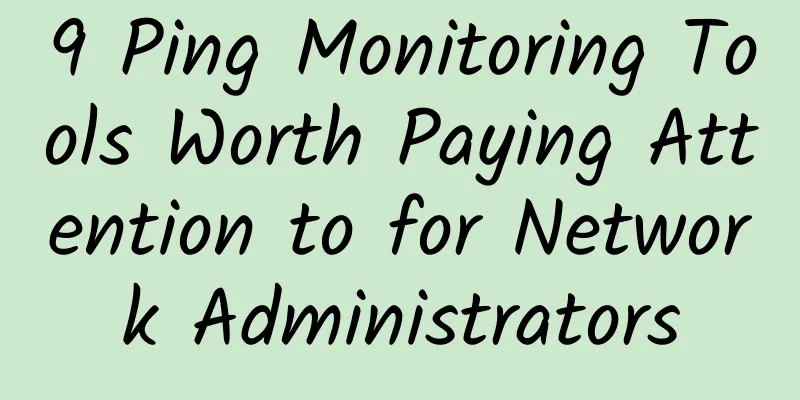9 Ping Monitoring Tools Worth Paying Attention to for Network Administrators

|
Ping monitoring is one of the most popular techniques used by network administrators to check the availability of network devices. But what is ping monitoring? Ping monitoring is when a user pings a device and waits for a response. The monitoring tool then assesses the strength of the connection based on the response time.
Using a ping tool to monitor a device will let you know if it is up or down. Monitoring your network in this way will give you a clear picture of the health of your critical devices. Here are 9 of the best ping monitoring tools.
1. SolarWinds Engineer's Toolset SolarWinds Engineer's Toolset is a network monitoring tool that supports ping monitoring. SolarWinds Engineer's Toolset provides a ping monitoring experience that can keep up with any workload. Devices connected to the network can be automatically discovered using the auto-discovery feature. Once the device is connected, you can view metrics such as availability, CPU load, memory utilization, and latency. All of this information gives you the foundation you need to view device performance. After extracting data from the pinged device, you can view the data in the form of graphs. These graphs show real-time responses so that you can process the critical information. After completing the monitoring, you can export them as image files or text files as needed. When using SolarWinds Engineer’s toolset, there’s no fuss about catching everything that happens, because there’s an alerting system that does this for you. Response time monitoring, memory monitoring, CPU monitoring, interface monitoring, and TraceRoute take care of this for you. This ensures that no matter what happens, you can react quickly. Overall, SolarWinds Engineer’s toolset provides a well-built ping monitoring platform. The software is well suited for small and medium-sized businesses, but also for larger enterprises. A 14-day free trial can be downloaded for evaluation. 2. PRTG Network Monitor We have also introduced Paessler PRTG Network Monitoring before. It is a very famous network monitoring tool that provides an excellent ping monitoring experience. You can ping devices in the network to measure their availability. With this tool, you can scan for devices to scan by IP range. It provides many different sensors that can be used for ping monitoring; these include Ping Sensor, Ping Jitter Sensor, and Cloud Ping Sensor. The advantage of this sensor network monitoring model is that it gives you a lot of detailed information. Each sensor has its own window, and you can choose between real-time and historical data before viewing the results. The Ping sensor gives you basic features such as ping time, minimum ping time, maximum ping time, and packet loss percentage. This gives you the basic information you need to see if there is a problem with the device. However, it also allows monitoring of more advanced ping issues like jitter. The Ping Jitter sensor allows measuring the network jitter on your network. This sensor displays statistical jitter values and the execution time of the request. Monitoring jitter is especially important in environments with important services like VoIP telephony. Of course, it also sends notifications if any specific thresholds are exceeded. The first 100 sensors are free to use. However, users with larger networks will need to purchase one of the paid versions. There is a 30-day free trial. 3. ManageEngine Free Ping and Traceroute Tool ManageEngine Free Ping Tool is a free ping monitoring tool recommended for those who want to deploy basic ping monitoring. With this tool, you can measure core metrics such as round-trip time, packet loss percentage, and hop count. You can also view the number of successful and failed ping counts to see how many times a device succeeded or failed the test. Even though it’s a basic tool, it still offers an easy-to-use dashboard. All the metrics for your ping test can be viewed in the main table view, along with the color-coded status of your devices. This allows you to see all the important information, even without the more advanced displays offered by other products on this list. It also has a notification system. If it sees that a device is unavailable, an alert is sent to the dashboard. This ensures that you don’t miss any information and ignore a developing problem. These alerts are based on thresholds so that you don’t receive too much irrelevant information. The only limitation of this tool is that it can only monitor up to 10 servers or websites at a time. This makes it unsuitable for large organizations. However, it still provides one of the best user experiences for those who are not accustomed to a more advanced monitoring experience. 4. Nagios XI Nagios XI is one of the most popular network monitoring tools in the world. However, Nagios XI also provides an excellent ping monitoring experience. With Nagios XI, you can view the availability of your devices and understand how common traffic loss is when your network is in transition. As a ping monitoring tool, Nagios XI provides a fusion of modern network monitoring and more classic visual displays, and also integrates more advanced displays such as network topology maps. However, if the user design does not meet your requirements, the layout can be customized for each user. This ensures that users have full control over how to monitor their network. For smaller businesses, Nagios XI can be downloaded for free on RHEL Linux and CentOS. It is also possible to use Nagios XI on Microsoft systems, but this must be done by using VMware Workstation or an alternative service. Therefore, Nagios XI is easiest to deploy in a Linux environment. Nagios XI has two paid editions, Standard and Enterprise. It offers a 60-day free trial. 5. Spiceworks Network Monitor Few network monitoring solutions are capable of monitoring smaller networks like Spiceworks Network Monitor. It offers a free ping monitoring solution designed specifically for small networks. The ping monitoring feature of the software allows users to ping devices throughout the network and view their status. Critical data about CPU, disk network usage, and memory usage can be viewed. All of this information is fed back into the dashboard. From the moment you add the IP and hostname of a device, it will appear on the dashboard. The dashboard has color-coded buttons that show if a device is classified as up or down. Whenever you want to add a new device to this core monitoring environment, you can do so manually by pressing the "Add Device" button. It has its own alert system to help you stay informed of network events. If any device on your network fails, you will receive an email alert. You can also customize your own alert parameters so that you are notified immediately when the ping time exceeds a certain time. It is a free tool. However, there are limitations on the number of devices that can be monitored. In addition to using Spiceworks Network Monitor, Windows 7, Windows Server 2008 R2, or Windows Server 2012 R2 is required. 6. EMCO Ping Monitor EMCO Ping Monitor provides the most underrated ping monitoring experience out there. In the Host Status Overview, you can view the hosts in your network, their status, ping response rates, and outage information. Each host can be monitored in real time with the help of color-coded graphs to see how the connection changes over time. This gives you a snapshot graph so that you can see if there are urgent issues that need to be dealt with. If you want to view your network from another perspective, you can view historical host data. Simply select the time period you want to monitor back. Once you have retrieved this information, you can create reports to send to other team members in PDF or HTML format. This simple setup can keep you close to what is happening on your network. One particularly interesting feature it offers is the ability to configure scripts. Scripts can be configured to run when network events occur. This allows you to incorporate a little automation into your monitoring experience. This can be supported through the use of alerts, which send you email notifications when changes occur. EMCO Ping Monitor is available as both a Windows program and a Windows service. It offers a free software version for up to five hosts. 7. PingInfoView PingInfoView is for scenarios where you just want to do a basic ping scan. With this lightweight utility, you can ping multiple hostnames and IP addresses at once to see if the connection is successful. This information is displayed in the main table view, which shows whether the connection succeeded or failed and the final ping time. Up devices are represented by green buttons, while down devices can be identified by red buttons. Although a basic tool, it is still possible to schedule regular ping sweeps to keep monitoring data up to date. PingInfoview can be configured to ping devices at a fixed interval of your choice. This ensures that the ping sweep data is accurate. Once you have completed pinging hostnames and IP addresses, you can save the results to text, html, or xml file formats. While this tool is not for those looking for visualization capabilities, PingInfoView does a good job of providing users with basic data. It is available for free on Windows 2000, Windows XP, Windows Server 2003, Windows Server 2008, Windows Vista, Windows 7, Windows 8, and Windows 10. 8. Dotcom-Monitor ICMP Ping Tool Monitor Dotcom-Monitor ICMP Ping Tool Monitor is a tool for Dotcom-Monitor's ping monitoring. With this product, you can send ICMP ping requests to assess the status of devices throughout your network. Ping tests are displayed in a graphical format so that you can track changes in responses over time. Devices that are up and running are simply marked as "OK" in the table below the graph view. Its alert system reduces the stress of manual monitoring. The alert system works based on thresholds and notifies you when a metric crosses a predefined threshold. This means you don’t have to keep track of details while monitoring your network. It is part of the web server-based monitoring product offered by Dotcom-Monitor. The price of this tool depends on the number of targets you need and how often you want to check. It offers a 30-day free trial. 9. Power Admin Power Admin's user interface looks a bit outdated compared to most of the above tools, but its ping monitoring capabilities are equally good in modern network environments. It can ping multiple IP addresses at the same time. In addition, it can track data on ping tests, CPU, memory, and disk usage. Power Admin has its own alert system that is designed to minimize the number of alerts you receive. For example, you will only receive ping alerts if two or more ping responses have not been received. The alert system also allows you to enter various other configurations. For example, you can choose a maximum response time for a successful ping and limit alerts to events where an error was detected within a certain time period. Configuring alerts in this way will prevent you from being notified every time a ping request fails! When a notification is raised, you know it’s a serious problem that needs to be addressed. It is only available on Windows. There is a 30-day free trial. |
<<: When WiFi Master Key quietly takes away your password, do you really not mind?
>>: IT maintenance: Five aspects of daily switch maintenance, all practical information!
Recommend
Zgovps Mid-Autumn Festival/National Day promotion, Japan IIJ/NTT/US AS4837 annual payment starts from 19.9 US dollars
Zgovps has released several special packages for ...
6 steps to effective real-time monitoring across hybrid IT
For data center operations, it can be difficult t...
EtherNetservers: $12/year-1GB/30GB/2TB/2IP/Los Angeles data center
There are not many merchants who still sell OpenV...
Ministry of Industry and Information Technology: Canceling the location of mobile phone numbers will increase the risk of telecommunications fraud
[[349030]] Can the location of mobile phone numbe...
DiyVM: Japan Osaka/US Los Angeles/Hong Kong Shatin CN2 line 2G memory VPS monthly payment starts from 50 yuan
DiyVM has recently made major changes to the webs...
Let’s talk about 6G communication technology again
2020 is coming to an end. With the advancement of...
Will Wi-Fi cost more than 5G connections?
This seems to subvert common sense! Recently, Eri...
How to implement a real-time monitoring system for tens of billions of visits?
[51CTO.com original article] The author has joine...
Risks and opportunities in the 5G era
At the end of 2018, the 5G frequency allocation o...
The world's largest brain-like supercomputer is launched: it has millions of processor cores
[[248667]] Image: This UK supercomputer can opera...
JuHost: Hong Kong VPS limited 40% off starting from $2.99/month, 1G memory, 20G SSD, 1TB monthly traffic
Last month, I shared information about JuHost, a ...
BuyVM restock, 1Gbps unlimited traffic in Las Vegas/New York/Miami/Luxembourg and other data centers starting from $3.5/month
BuyVM has currently restocked a large number of V...
Tencent Cloud Light 1C2G3M is only 253 yuan (or 83 yuan/year) for three years, shared by new and old users
Tencent Cloud's Double 11 event is still vali...
LOCVPS: VPS in the United States/Netherlands/Germany/Australia 40% off, starting at 22 yuan/month, Hong Kong/Korea/Japan 20% off
LOCVPS has launched a February New Year promotion...
A heated debate among various parties: How far are we from a 5G hit?
[Original article from 51CTO.com] Remember that t...





![[Black Friday] spinservers: Dallas/San Jose dedicated servers starting from $59/month, E3-1280v5/32G/1TB NVMe/10Gbps bandwidth](/upload/images/67cac01c72246.webp)



